Giant mudskipper
Table of Contents
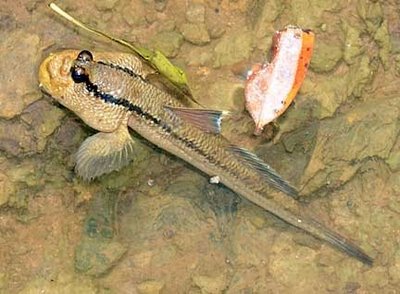 |
| Giant mudskipper at Chek Jawa. Photo credit: Ria Tan |
Name
- Current scientific name: Periophthalmodon schlosseri (Pallas, 1770)
- Common name: Giant mudskipper
Brief Interesting facts
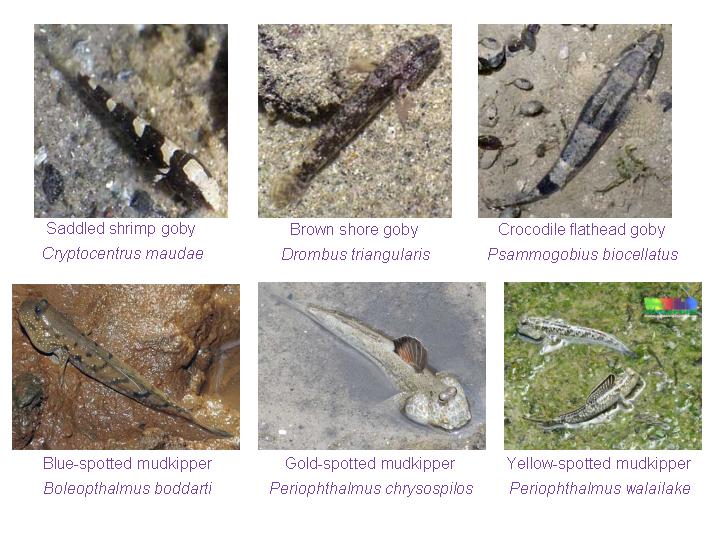 |
| Family Gobiidae includes both gobies & mudskippers. Photos credit: Ria Tan |
- The giant mudskipper comes from Family Gobiidae, the largest family of fishes consisting of 212 genera and 1875 species!
- As its name "giant mudskipper" suggests, this is largest species of mudskippers native to Singapore, which can grow to a maximum length of 27cm (Kottelat et al., 1993) ! Its prominent size often allows it to be easily distinguished from other mudskipper species.
- Literally a fish out of waters, it has
acquired several special adaptations for amphibious living.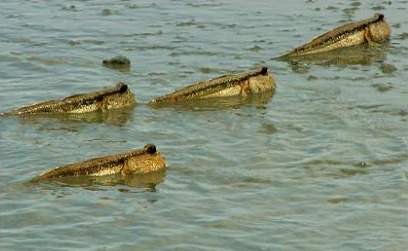
Photo credit: Chistoph Keller (approval pending)
- Despite being a freshwater fish, this species is euryhaline, hence able to cope well with salinity fluctuations in the mangrove habitat.
Biology
Distribution
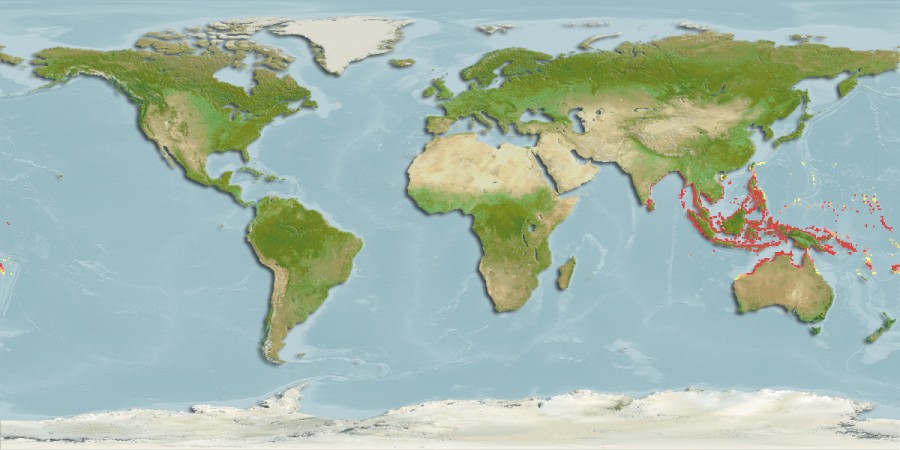 |
| Computer generated map indicating the giant mudskipper native range (in red). Photo obtained from: Fishbase |
Native range: Indo-West Pacific (indicated in red); encompassing countries such as Singapore, Malaysia, Indonesia,
Thailand and India.
Habitat
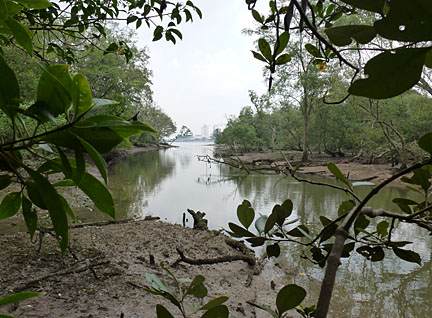 |
| Mangrove habitat Photo credit: Ria Tan |
- Giant mudskippers mainly inhabit the muddy shores of mangroves (and adjacent prawn ponds)
- They can be spotted at Chek Jawa, Sungei Buloh Wetland Reserve and Pasir Ris mangroves.
- Being euryhaline allows them to thrive in both the lower reaches of rivers (freshwater environment) and the sea.
Terrestrial adaptations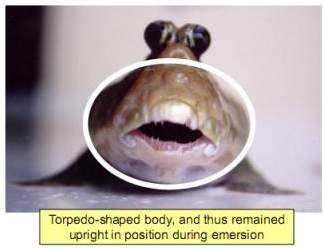
Photo credit: Ip, Y.K.

Eyes
- Positioned above head. This confers a good 360º view and increases efficiency in predator spotting.
- Can be retracted and re-moistened by water that collects at the bottom of the eye socket
Torpedo-shaped body
- Enables it to remain upright during emersion
Gills
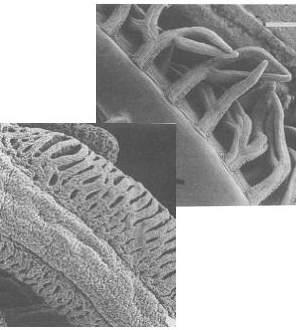 |
| Complexly branched gill filament (Top right). Extensive interlamellar fusions (Bottom left). Photo credit: Low et al. (1988) |
- Short, branched gill filaments are well supported by thick gill rods. This prevents gills from collapsing easily during terrestrial exposure, hence remains functional as a respiratory organ (Low et al., 1988).
- Extensive fusion of secondary lamellae also contributes to gills support. Spaces resulting from such fusions trap water and keeps the gills moist (Low et al., 1988).
Other respiratory organs
- Buccal cavity (Randall et al., 2004) and skin
- Both these organs are well-vascularized (enriched with blood capillaries). They allow direct absorption of gaseous oxygen via their epitheliums so long as they remain moist. It is for this purpose, that the giant mudskipper frequently rolls itself in puddles or wet mud.
Fins
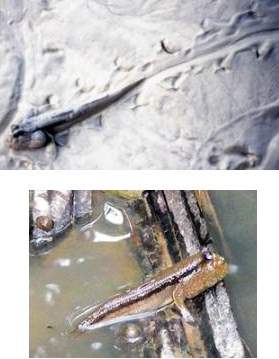 |
| Photo credits: Ip, Y.K. (Photo above) and Ron Yeo @tidechaser.blogspot.com(Photo below) |
- Movement on land occurs in short hops. This is achieved by both pectoral fins 'jerking' forward, while the body is kept rigid.
- When climbing roots or rocks, its pelvic fins act like suckers to hold the body against the vertical surface, while pectoral fins 'reach up' and 'pull' the entire organism up.
Feeding Habits
Diet types and preferences:
- The giant mudskipper is a generalist carnivore.
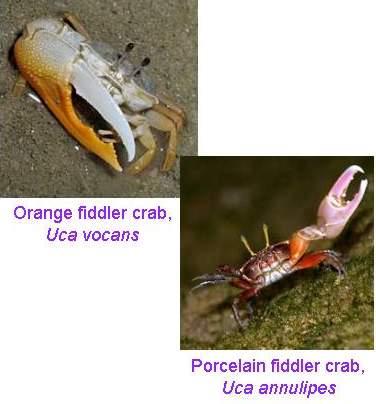
Fiddler crabs (Uca spp.) Photos credit: Ria Tan.
- Diet types: Crabs, prawns, insects, worms and mollusks (Murdy, 1986; Mazlan et al., 2006)
- Feeding period: Primarily during low tides (Mazlan et al., 2006)
- During day low tides: Crabs, especially fiddler crabs are the preferred food types due to their abundance.
- During night low tides: Giant mudskippers observed to undergo diet switch from crabs to insects due to reduced availability of crabs.
Foraging tactic:
- Ambush predator. (Spots prey -> minimizes movement, stalks and takes aim -> pauses momentarily -> leaps forward to capture prey with its mouth) (Mazlan et al., 2005)
- It then moves to a safe place (burrow, shallow water holes, or small crevices) to feed.
- Interestingly, male mudskippers are capable of searching for prey up to 4200 square feet from its burrow (Murdy, 1986).
Highlight of video: 0.00-0.16 sec
Predators
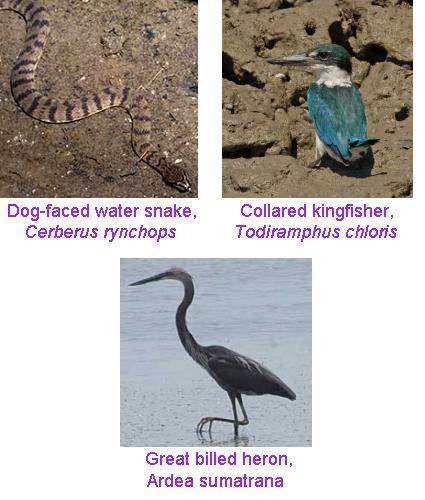 |
| Natural predators. Photo credits: Ria Tan (top left & bottom photo); Dave Bakewell (top right photo) |
- Natural predators: Dog-faced watersnake (Cerberus rynchops), herons and kingfishers.
- They escape avian predators by rapidly 'skipping off' to a sheltered place or their burrows. However, this strategy fails to defend them against the dog-faced watersnake, which can slither down their tunnel to catch them.
- Giant mudskippers are also preyed upon by humans for food and traditional medicine purposes (Mazlan & Rohaya, 2008)
Reproduction
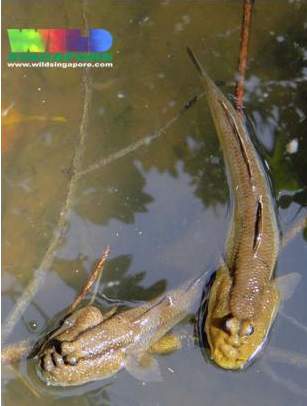 |
| Photo credit: Ria Tan |
Breeding season: Estimated to occur from June to October, which corresponds to the southwest monsoon (Mazlan & Rohaya, 2008)
Male:
- Become more active and colour intensifies during the breeding season
- Burrows are created by scooping out balls of mud with their mouths. A low wall built around the entrance allows tidal pool formation. The tunnel spans a diameter of ~ 8cm and a depth of ~ 1.2m.
- Displays courtship dance (comprising of leaps, flips and even tail-stands) as a mate-attractant strategy
- Displays aggression towards rival males (dorsal fin erection, biting and even attempts to throw each other)
Female:
- Exhibits her own mating ritual when she is attracted to the male
 |
| Eggs within nesting chamber. Illustration by: Melody Soh. |
- She then enters the male's burrow to lay her eggs on the walls of the nesting chamber, which will be eventually fertilized by the males (Mazlan & Rohaya, 2008)
Brood care responsibility:
- Undertaken by the male
- It repeatedly gulps air from the burrow surface and releases it into the nesting chamber. Eggs are therefore well-oxygenated despite the waters in the burrow being severely hypoxic.
The giant mudskipper is not featured here. However, certain processes (courtship dance, aggression to rivals, rolling in mud and broodcare activities) are featured by other mudskipper species.
Highlight of video: 1.15s- 4.52 sec
Basic Life Cycle
- Fertilized eggs develop into embryos
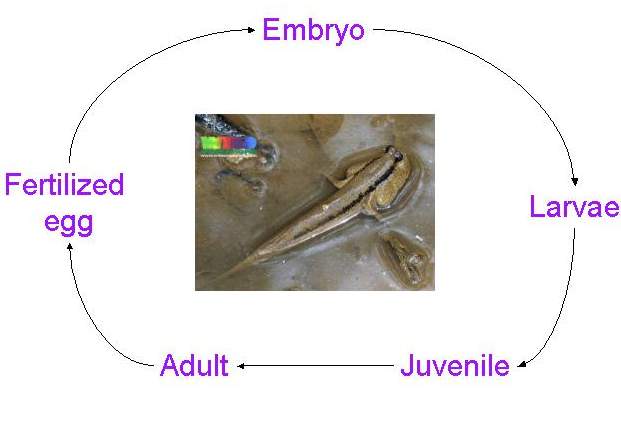
Basic life cycle of the giant mudskipper. Photo credit: Ria Tan. Diagram by: Melody Soh.
- The hatching process is promoted by a hatching gland, positioned above the head of the embryo (Tsuhako et al., 2003).
- The larvae eventually emerges and remain in the burrow until they metamorphosize into juveniles
- Juveniles stay in close proximity to tidal pools around their nest entrance.
- Adult giant mudskippers can grow up to a maximum length of 27cm. Females reach maturity ~ 12-14cm (Mazlan & Rohaya, 2008). No corresponding data has been provided for males, except that they mature relatively slower than females (Mazlan & Rohaya, 2008).
Status and Threats 
Debris in Pasir Ris Mangrove. Photo credit: Ria Tan.

- IUCN red list status: not evaluated
- Listed among the threatened animals of Singapore
- Human threats: habitat destruction, pollution, captured for food.
Taxonomy
Synomyns
(It is important to note that synonyms in taxonomy, unlike other context, are non-interchangeable. Only one scientific name is deemed correct for any given taxon at a given point of time. Synonyms arise during a change in existing taxa (E.g. movement of a species to a different genus) or when the same taxa is described and named more than once independently.)| Scientific name |
Remarks |
Valid |
| Gobius schlosseri (Pallas, 1770) |
Original combination |
X |
| Periophthalmus schlosseri (Bloch & Schneider, 1801) |
Misidentified |
X |
| Periophthalmus ruber (Bloch & Schneider, 1801) |
Taxonomically revised (Murdy, 1989) |
X |
| Periophthalmus phya (Johnstone, 1903) |
Taxonomically revised (Murdy, 1989) |
X |
Etymology
(Etymology studies the origin and development of words. It is useful in providing an understanding of how the scientific name of the giant mudskipper was derived and how it relates to the organism)- Generic name: Periophthalmodon
- Species name: schlosseri
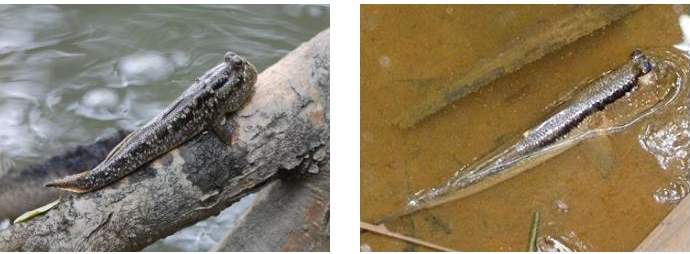 |
| Yellow-spotted mudskipper, Periophthalmus walailake (Left) & giant mudskipper, Periophthalmodon schlosseri (Right). Photo credits: Tan Heok Hui & Ron Yeo @tidechaser.blogspot.com respectively. |
Taxonavigation
(This enables one to trace the ancestry of the giant mudskipper)- Kingdom: Animalia
- Phylum: Chordata
- Class: Actinopterygii
- Order: Perciformes
- Family: Gobiidae
- Subfamily: Oxudercinae
- Genus: Periophthalmodon
- Species: schlosseri
Diagnosis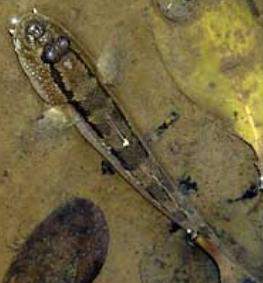
Photo credit: Ria Tan.
(This helps distinguish the giant mudskipper from other species. It is especially crucial for the researchers as incorrect identification might the use of the wrong species, which leads to inconsistencies in results and incur financial damage)
(Information from Murdy, 1989):
Genus level identification
- Two black stripes (brown in preservation) run posteriorly from each eye to the caudal peduncle
- Possesses two rows of teeth in the upper jaw (this is also the key feature that distinguishes genus Periophthalmodon from Periophthalmus, which only has a single row of teeth)
Species level identification
There are three species within genus Periophthalmodon:
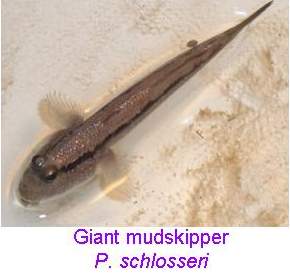 |
| Photo credit: Gianluca Polgar. |
P. schlosseri, P.freycineti and P. septemradiatus.
P. schlosseri can be identified via the following morphological features:
1. Spinous dorsal fin (D1) base length greater than 10%SL(standard length), ranging 10.3-16.7%SL
2. D1 VI-IX (i.e. D1 has 6-9 unbranched dorsal fin rays)
3. Pectoral fin rays: 16-19
4. Pelvic fins with frenum and completely united
5. Isthmus lacking scales
6. Snout completely scaled
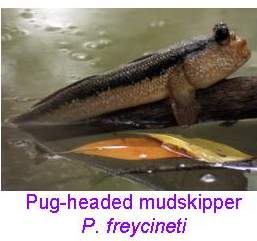 |
| Photo credit: Gianluca Polgar. |
Features (1) & (2) differentiates P. schlosseri from
P. freycineti, which has:
- D1 base less than 10%SL
- D1 IV-V (i.e. has 4-5 unbranched fin rays)
Features (3) to (6) distinguishes P.schlosseri from
P. septemradiatus, which has:
- Pectoral fin rays: 12-15
- Pelvic fins lack frenum and separated to fin bases
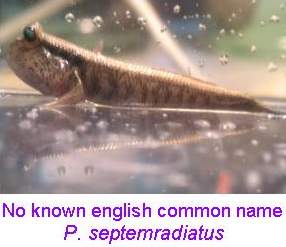
Photo credit: Gianluca Polgar.
- Isthmus completely scaled
- Snout lacking scales
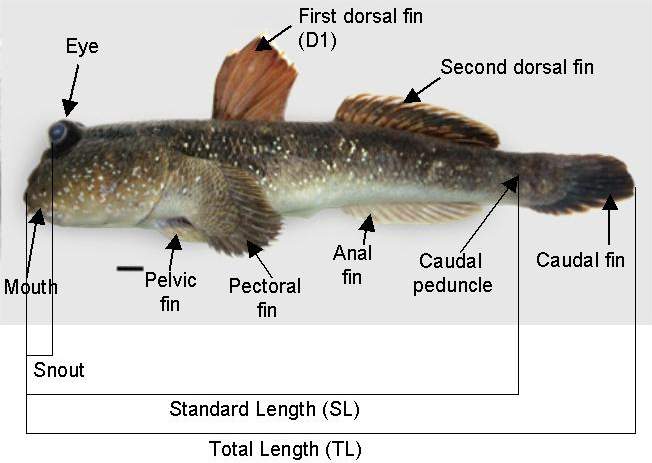 |
| External anatomy of the giant mudskipper. Photo credit: Gianluca Polgar. Modified by: Melody Soh (permission granted) |
 |
| Pelvic fin types. Diagram from: A guide to gobies of Singapore (Larson & Lim, 2005) |
Description
(This aids in the identification of the mudskipper. The original description is of particular importance as it was penned when the species was newly discovered and contains details of its morphology and illustrations of the type material.) 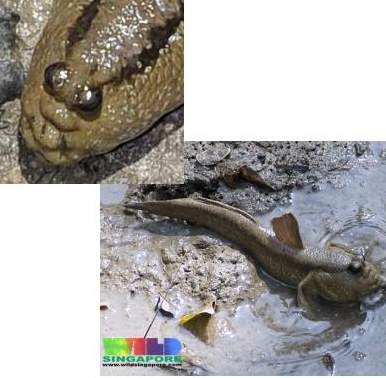
Top positioning of eyes (Above). D1 erected (Bottom). Photos credit: Ria Tan

(Adult)
Size
- Maximum: 27cm (Kottelat et al., 1993)
Eyes
- Positioned at the top of head
Teeth
- Two rows of teeth in upper jaw
- Outermost row teeth enlarged and curved (Larson & Lim, 2005)
Fins structure:
- Spinous dorsal fin (D1): first spine is large and can be erected to hoist up the fin
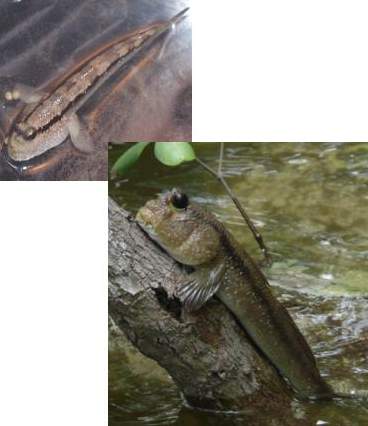
Prominent black stripes (Above). Bluish white speckles on body (Bottom). Photo credits: Gianluca Polgar & Sivasothi N. respectively
- Pectoral fins: well developed; 16-19 rays
- Pelvic fins: completely fused
Body coloration
- Greenish brown trunk
- Two black stripes running continuously from each eye to the caudal peduncle
- Presence of numerous bluish white speckles
Original description (in German)
- E book version of: Pallas, P. S. 1770. Spicilegia zoologica quibus novae imprimis et obscurae animalium species iconibus, descriptionibus atque commentariis illustrantur. Fasciculus octavus. - pp. 1-54, pl. I-V [= 1-5]. Berolini. (Lange).
- Pages: 5-6
- Illustrations: Table 1. (Figures 1-4)
Phylogenetic position
(The phylogenetic tree shows the inferred evolutionary relationships among 10 genera of subfamily Oxudercinae. It allows one to understand how closely related/similar the genus Periophthalmodon is from other genera)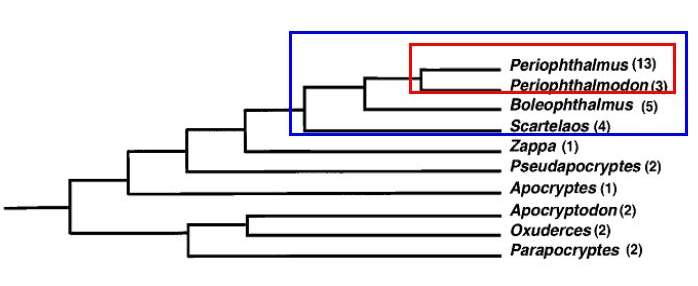 |
| Figure taken from Graham & Lee (2004), which was originally adapted from Murdy (1989) (Approval pending) |
- It was constructed based on both structural and behavioural traits (refer to Graham & Lee (2004) & Murdy (1989) for greater details)
- Blue box: A monophyletic group comprising four genera (Periopthalmodon, Periophthalmus, Boleophthalmus & Scartelaos), which has the greatest degree of specialization for air-breathing and terrestrial life.
- Red box: Highlights the strong relationship and similarity between sister groups Periophthalmodon and Periophthalmus
Type information
(The type material is the first specimen(s) to which the scientific name of the newly discovered species was formally attached and the original description was made. It serves to anchor the defining features of that particular species and may referred upon when there are uncertainties on the original description or the identities of later specimens.)- Based on the original name Gobius schlosseri assigned by Pallas (1770), the type material no longer exists. They type locality was listed by Gmelin (1789) and Shaw (1803) to be Ambon (Indonesia) (Murdy, 1989).
- The species Periophthalmus ruber (Bloch and Schneider, 1801) and Periophthamus phya (Johnstone, 1903) and currently are synonymized as Periophthalmodon schlosseri (Murdy, 1989).
- The holotype of Periopthalmus ruber (ZMB 2143) and syntypes of Periophthalmus phya (BMNH 1904.1.30.19-21(3?) are presently available. (Refer to Murdy (1989) for details)
Related Links
Giant mudkipper on Ecology Asia
Giant mudskipper (Periophthalmodon schlosseri) from Fishbase
Giant mudskipper (Periophthalmodon schlosseri) from Fishwise
Periophthalmodon schlosseri on The mudskipper
Giant mudskipper (Periophthalmodon schlosseri) on wildfactsheets
Giant mudskipper (Periophthalmodon schlosseri) on Mangrove and wetland wildlife at Sungei Buloh Wetlands Reserve
References
[1] Graham, J. B. and Lee, H. J. (2004). Breathing air in air: In what ways might extant amphibious fish biology relate to prevailing concepts about early tetrapods, the evolution of vertebrate air-breathing, and reviewed work(s). Physiol. Biol. Zool. 77 (5). pp. 720-731.
[2] Kottelat, M., Whitten, A. J., Kartikasari, S. N. and Wirjoatmodjo, S. (1993). Freshwater fishes of Western Indonesia and Sulawesi = Ikan aie tawar Indonesia Bagian Barat dan Sulwesi. Periplus Editions, Hong Kong. 344 p.
[3] Larson, H. K. and Lim, K. K. P. (2005) (eds)- A guide to Gobies of Singapore- Omni-Theatre, Singapore Science Centre, Singapore:164pp.
[4] Low, W. P., Lane, D. J. W. and Ip, Y. K. (1988). A comparative study of terrestrial adaptations of the gills in three mudskippers: Periophthalmus chrysospilos, Boleophthalmus boddaerti, and Periopthalmodon schlosseri. Biol. Bull. 175: 434-438.
[5] Mazlan, A. G. and Rohaya, M. (2008). Size, growth and reproductive biology of the giant mudskipper, Periophthalmodon schlosseri (Pallas, 1770), in Malaysian waters. J. Appl. Ichthyol. 24: 290-296.
[6] Mazlan, A. G., Yakob, F., MD. Nor, S. and Arshad, A. (2006). Foraging behavior and food selection of giant Mudskipper (Periophthalmodon schlosseri) at Kuala Gula, Matang Mangrove Reserve, Perak, Malaysia. Coastal Marine Science. 30 (1): 263-267.
[7] Murdy, E.O. (1986). Mudskippers of Malaysia: The Lord of the Mudflat- Freshwater and Marine Aquarium Nov. 1986: 20-23.
[8] Murdy, E.O. (1989). A taxonomic revision and cladistic analysis of the oxudercine gobies (Gobiidae: Oxudercine). Records of the Australian Museum. Supplement 11.
[9] Pallas, P. S. (1770). Spicilegia zoologica quibus novae imprimis et obscurae animalium species iconibus, descriptionibus atque commentariis illustrantur. Fasciculus octavus. - pp. 1-54, pl. I-V [= 1-5]. Berolini. (Lange).
[10] Randal, D. J., Ip, Y. K., Chew, S. F. and Wilson, J. M. (2004). Air-breathing and ammonia excretion in the giant mudskipper, Periophthalmodon schlosseri. Physiol. Biol. Zool. 77(5): 783-788.
[11] Tsuhako, Y., Ishimatsu, A., Takeda, T. Huat, K. K. and Tachihara, K. (2003). The eggs and larvae of the giant mudskipper, Periophthalmodon schlosseri collected from a mudflat in Penang, Malaysia. Ichthyol. Res. 50: 178-181.
| Subject | Author | Replies | Views | Last Message |
|---|---|---|---|---|
| No Comments | ||||